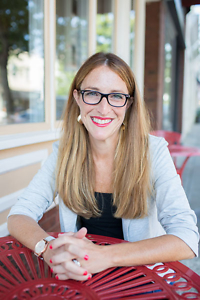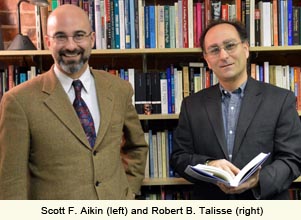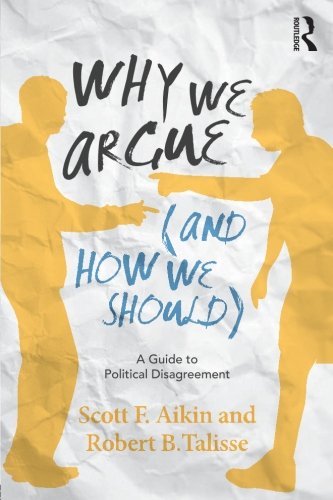Problims Solved
Natalie Lloyd talks with Chapter 16 as she concludes her Problim Children series
“Life would be so boring without danger,” declares daredevil Mona Problim in Island in the Stars, the third book in Natalie Lloyd’s Problim Children fantasy series. “How would you ever know what you were made of if you didn’t risk your life now and then?” In this final installment of their story, Mona and her siblings are off to sea on another great adventure. They must rescue their youngest brother, Toot, from the clutches of a villain nicknamed “Cheese Breath,” who seeks to trade Toot for the location of a fountain of youth on a mysterious island.
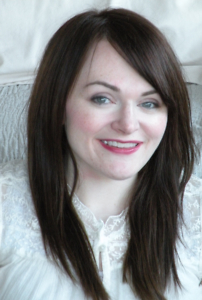 Continuing to follow the cryptic clues their Grandfather Problim left for them — a process begun in the first book — the siblings must use the extraordinary power they wield over the elements to destroy the fountain, whose magical water extends life at far too great a cost. They also hope to find their often-missing, world-traveling parents along the way. (For maximum enjoyment, those new to the Problims are advised to read this intricately plotted series from the beginning.)
Continuing to follow the cryptic clues their Grandfather Problim left for them — a process begun in the first book — the siblings must use the extraordinary power they wield over the elements to destroy the fountain, whose magical water extends life at far too great a cost. They also hope to find their often-missing, world-traveling parents along the way. (For maximum enjoyment, those new to the Problims are advised to read this intricately plotted series from the beginning.)
As the Problims search frantically for their brother, Lloyd keeps the chaotic fun flowing and introduces little life lessons for her middle school readers to ponder. One of the most poignant comes from a friend who talks about his sadness over the death of his dog: “I’ve realized, I guess, that the missing place isn’t bigger than the loving place. I love her even more than I miss her, if you can believe it.” Fans of this series are sure to miss the funny, sweet, kooky, and brave Problim children.
Lloyd answered questions from Chapter 16 via email.
Chapter 16: The Problim Children is your first series. What surprised you most about writing a series versus a single novel?
Natalie Lloyd: When I first imagined the seven Problims, I could see their story arc stretching across a few books. I liked the idea of writing about siblings as a whole, but it was also fun to use each book to focus on one or two of them. That said, the kind of mind mapping required for a series was way more extensive (for me, at least) than writing a single novel — even more than I imagined. But it was also a really fun challenge. I like to write about how families connect, how our siblings bring out the best (or sometimes worst) in us, and how people grow individually even within a close family. I knew I wanted more than one book for that wildly weird bunch. I hope I gave them a proper sendoff.
Chapter 16: What is it like for you as the author to say goodbye to such colorful characters? Is there a Problim child that you most identify with?
Lloyd: This is such a fun question, because it really does feel like saying goodbye. I’ve spent a few years now with the Problim family, and they’re all so vivid and real in my imagination. Their stories made me feel like I was a little kid again, having adventures with my siblings and cousins. We didn’t have a human catapult (not that I remember), but there was a freedom and wildness we found in each other that I tried to give the Problims. It’s bittersweet to let them go.
The second answer to this question could also double as one of the things that most surprised me. I ended up feeling most connected to Mona Problim. And Mona is the character I thought I would connect with the least. I wrote Mona as a blend of Audrey Hepburn and Wednesday Addams. She’s moody, bold, loves darkness (“the color and the mood,” she would say), and lives to prank her siblings, especially her brother Sal. Her siblings joke that she’s “probably evil.”
Personality-wise, I’m more like Thea Problim: tentative, dreamy, protective over people I love. But I still connected more with Mona. I wonder if it’s because so much of Mona’s “crusty” exterior is really her way of ferociously guarding her heart. Past the cynicism, she loves her family deeply and has an insatiable curiosity about the world around her.
I’m also very attached to Violet O’Pinion, who adventures regularly with the Problims. I gave Violet a dog named Biscuit, named for my sweet Biscuit who passed while I was writing this series. That’s one reason I feel connected her. But I also ended up putting much of myself in Violet. I think the Problim story is finished, overall. But I would love to write more about Violet someday.
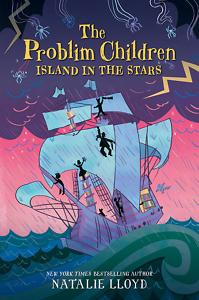 Chapter 16: Your stories emphasize leading with one’s heart, being brave, and taking risks, especially when fighting against injustice. Do you begin a writing project with a message in mind, or do you begin with story and characters and allow themes to develop naturally?
Chapter 16: Your stories emphasize leading with one’s heart, being brave, and taking risks, especially when fighting against injustice. Do you begin a writing project with a message in mind, or do you begin with story and characters and allow themes to develop naturally?
Lloyd: I never think of a message or theme going into a story. I think it would feel too forced if I tried. The characters always show me what their journey is going to be as we go along. If a reader enjoys a book, I consider that a huge success. But there’s certainly a part of me that hopes they’ll see all of those themes you mentioned. That they’ll know their words matter and are important. And that they realize they aren’t alone in the world.
I believe books belong to readers, so it’s exciting to know what themes and meanings they see in a story, even if it’s not what I saw when I was writing.
Chapter 16: The Chronicles of Narnia was a pivotal series in your childhood reading. You have said, “I believe that once you are a queen in Narnia you are always — always — a queen in Narnia.” What was it about the Narnia books that spoke to you so deeply as a child?
Lloyd: I tell young readers that The Lion, the Witch and the Wardrobe is the first book I remember feeling, not just reading. I could feel Lucy’s fear, excitement, and wonder. It’s the kind of book I needed a blanket to read because I felt the cold snow of a place where it was “always winter, never Christmas.” What I didn’t realize at the time is that I also felt as brave as the characters. That’s one of the most magical things to me about a book. Even when the story is fictional, the courage you pull from the pages becomes yours. It becomes real and belongs to you. I was born with a physical disability that causes lots of broken bones, and to get through that when I was little, I would imagine Aslan. I would imagine his fur between my fingers and how his roar would feel in my chest. How it would feel if it were my roar. It was more than a book for me; it was a lifeline. I think most book lovers have a story that’s like that for them.
Chapter 16: You are open about your physical challenges, writing, “I was born with a brittle bone disease called osteogenesis imperfecta (OI) and used a wheelchair or walker until seventh grade.” How have your health struggles affected the kinds of stories you want to tell or the characters you create?
Lloyd: I think living with a disability affects the stories I write in so many ways, probably in ways I don’t even realize. It certainly influenced how I connected to a book as a reader, and maybe that’s where I should start.
I read a novel years ago in which the villain was described very physically. Specifically, I remember the word “asymmetric” and the great detail about the mangled, disfigured body of the villain. The hero was described as kind of traditionally fairy-tale beautiful: tall and thin and blond. And I remember almost immediately looking in the mirror at the asymmetry of my own body, because of severe scoliosis. At the asymmetry of my legs, which have bone deformities because of all the fractures. That one tiny description burrowed down deep in me.
But it also made me even more committed to writing about all kinds of characters in all kinds of bodies. I want to do a better job of championing stories full of all kinds of bodies, too. And I want to make sure no physical trait in my story is assigned solely to a villain: that’s got everything to do with crooked hearts, not my curved back.
In my first novel, A Snicker of Magic, one of the main characters (Jonah) was in a wheelchair (like I was, and sometimes am), but the reader never discovered why. The reader sees his life and how he adapts (with a wheelchair lift on the bus, for example). In The Problim Children, Violet has to wear a helmet constantly because of a severe allergy to air. Her family is extremely protective, to the point where she’s kind of secluded in her room. The whole series shows Violet gradually finding her independence, slowly testing her boundaries and limits, and seeing what it might look like to live in a world where people will notice she’s different. Mallie, in Over the Moon, doesn’t have a left hand — her arm ends past her elbow. In her story, I wanted to show how this very physical, active girl moved through this big adventure in her own way. Mallie never doubts her ability to do something; she just does it her way.
I’m also working on my first project with Scholastic about a girl who has OI, the same bone disease I have. This is the first time I’ve written about my disability through a character, and my hope is to be as authentic as possible with it all. The experience of living with a disability is so different, person to person. But I’m opening my heart wide about my own experience. Most decisions I make are filtered through the lens of being disabled. I think it’s okay — it’s necessary — to write about disability as something that’s young, as well as old. As something that affects every decision. As one part of a “wild and precious life,” as poet Mary Oliver would call it.
Through every story I write, characters realize they are not fragile. Their bones might be fragile. Their hearts might be broken. But they are stronger than they could possibly imagine and capable of infinite magic.
Chapter 16: In what ways have your interactions with young fans at schools and festivals impacted your decisions and goals as an author? For instance, do you have a particular audience in mind as you write?
Natalie Lloyd: Most writers have heard the advice that you can only really write a book for yourself. And that’s true. All writing is totally subjective and bends to trends and whims and a billion things no writer can control. But I am keenly aware that I’m writing for young readers, and those interactions remind me what a precious gift that is. Connecting with young readers is the best. And I honestly can’t think of a bigger honor as an author than writing a book that a young reader wants to read. They are imaginative, openhearted, so smart, kind, and passionate. They make me want to write better and live better. So, yes, for me, I’m always thinking of the young readers I write for.
Chapter 16: What does your writing practice look like, and how have the recent months of quarantine affected it?
Natalie Lloyd: On a perfect writing day, all I need is a blanket and my dog, and we settle in beside a window and get to work. It would be raining, ideally. And I would freehand a little bit in a notebook about the scene I want to work on, just to get started. Then I would type “like my fingers are on fire,” as author Kathi Appelt says. But that’s not every day. I try to lean into the advice of one of my favorite writers, Nina LaCour, who says to aim for “some words on most days.” If I do that, if I give myself that kind of grace, I tend to get a lot more writing done.
For any creative, I think it’s easy to let any anxiety or worry happening around you leak into that creative space you want to protect. It’d be nice if you could always process circumstances and emotions through some kind of writing catharsis. But it doesn’t always happen. And I think that’s been especially true for many of my writer friends during quarantine, especially caregivers. My personal routine hasn’t changed a whole lot, but I do have to try to keep fear and worry from edging into the creative space I want to protect. In times like this, deadlines feel like a real gift, honestly. They teach me to fight through all of the fear and work to create something good.
Chapter 16: What’s up next for Natalie Lloyd fans to look forward to?
Natalie Lloyd: For years now, I’ve been working on a novel that was released as an Audible original in July. The story is called Silverswift, and it’s the tale of an adventurous granny, a brave 11-year-old girl, and a storied mermaid who captivates them both. I loved every second of writing it, and I’m thrilled it’s a book readers get to read with their ears now.
My next print novel is slated for 2022, which seems like forever away. But it’s important for me to be able to take my time and discover it. In a wild twist of events, Sony recently purchased television rights for my first novel, A Snicker of Magic, so it’s also been very exciting to see stirrings for that project begin. I’ve seen the first inkling of a script, which was such a cool experience. I hope readers get to see it play out. I know they’ll love it. I love writing stories, and I’m so excited I get to share them. Readers sometimes ask me how many books I want to write. My answer is as many as I can or as many as you’ll read. There are so many stories I can’t wait to tell, and I still can’t believe people besides my parents want to read them. But, wow, am I grateful.
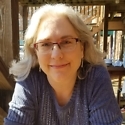
Tina Chambers has worked as a technical editor at an engineering firm and as an editorial assistant at Peachtree Publishers, where she worked on books by Erskine Caldwell, Will Campbell, and Ferrol Sams, to name a few. She lives in Chattanooga.


